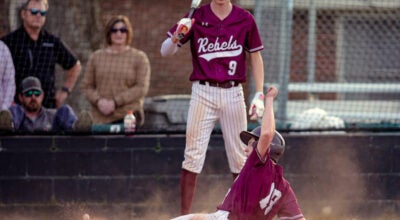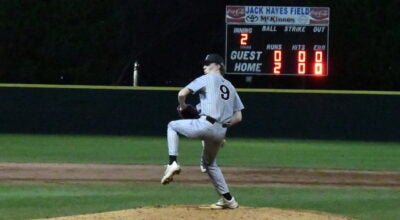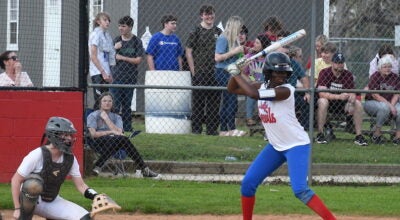Upstart teams hoping to make a splash at 500
Published 11:43 am Wednesday, February 11, 2009
DAYTONA BEACH, Fla. — Joe Nemechek sits on a couch in his sparsely decorated trailer near the back of the garage area at Daytona International Speedway, monitoring Daytona 500 qualifying on a computer while a TV hums in the background.
“This is me,” the 16-year NASCAR Sprint Cup veteran says, shrugging his shoulders.
No handlers. No fans. No flashy sponsor logo eating up real estate on the side of his hauler. All that stuff is over in the main garage area, where NASCAR’s brightest stars and most powerful teams hog the spotlight.
Over here, tucked back in the corner — closer to Turn Four than pit road really — Nemechek is just another owner/driver/businessman/promoter trying to find his way onto the starting grid for the Daytona 500.
Welcome to the other side of the track.
“When I started racing, I had to earn everything I got,” Nemechek said. “It was a whole different deal. … What we’re doing right now is kind of back to that.”
The 45-year-old Nemechek spent the winter reaching out to the people he’s met during his moderately successful career trying to line up a major sponsor for the 2009 season. He didn’t find one, but came to Daytona anyway hoping a spot in NASCAR’s biggest race will help him find the kind of investors it takes to sustain even the smallest of teams through the grueling 36-race season.
Nemechek is hardly alone. The auxiliary garage is filled with programs like his searching for some financial stability and a chance to dash for cash. From series regulars like Jeremy Mayfield to relative unknowns like Carl Long and Norm Benning, the opportunity to take a flier at Daytona is simply too tempting to pass no matter what the cost.
Yet getting there requires plenty of creativity, especially on a shoestring budget.
While NASCAR’s premier teams, like Joe Gibbs Racing and Hendrick Motorsports, bring small armies to the track, 1990 Daytona 500 winner Derrike Cope has just four members prepping his No. 75 Dodge and nobody gets the luxury of having just one job.
Cope’s engine builder drives the trailer while he works on the shocks. Stop by the hauler and ask Cope how he’s doing and he’s liable to put you to work.
“We’re a small group with a lot of heart and desire and we’re going to try and do all we can,” Cope said.
Even if it means trying to qualify a car without a lick of testing. NASCAR banned offseason testing in an effort to save money. While doing so helped teams pinch enough pennies to save up for Daytona, it also meant they had precious little time to get a good package together once they got to the track.
It’s why Mayfield was all smiles on Sunday despite a so-so qualifying run. Three weeks ago, he didn’t even have a big-dollar sponsor for his Mayfield Motorsports No. 41 Toyota before All-Sport stepped in and pledged to support a full schedule.
“We realize you can’t just do what we did,” Mayfield said.
Time is something in short supply for Cope and Nemechek. Both drivers are already planning to run a partial schedule at best. Failing to make Daytona could severely limit their options.
If they manage to make the field and collect the six-figure check just for showing up, the money goes right back into the program in an effort to stay afloat.
“We’ve got to run it in the black,” Cope said. “We’ve got to run this thing on its means. We go race to race. If we can get in the race here then we’ll be in California. If not we’ll probably pull our horns in unless a company comes through with a little bit of money.”
A little bit of money — by NASCAR’s standards anyway — might be all it takes. Having such a small team means overhead is relatively low. A business trying to reach a new market might not have to dig too deep into its pockets to have its logo across the front of a Sprint Cup car.
“A company can come in and spend less money with us and still have a ticket to the dance,” Cope said. “It’s a platform, a validation for the consumer and race fans and you use it as that.”
Besides, in a job market that appears to be getting worse by the day, the smaller teams are the land of opportunity. Some of the circuit’s biggest programs have cut dozens of positions over the last year in an effort to streamline. Help wanted signs are rare.
Call it NASCAR’s stimulus package.
“I’ve created some jobs for not only myself, but for a few employees, and if the deal is going better there are going to be a lot more employees,” Nemechek said. “One of our goals this year is just with the way the economy is we’re going to do a lot more for a potential sponsor or partner for a lot less than what a lot of these teams are doing.”
No one is certain whether this run of startups will last when, or if, the economy recovers. There is something refreshing, however, to the sudden uptick in upstarts.
In a way, it’s a reminder of the days before NASCAR went global, when owners of relatively modest means like Raymond Beadle won championships before millions were poured into research and development, sending the cost of fielding a competitive team soaring.
The introduction of the bulkier, safer “Car of Tomorrow” two years ago has helped level things out. The car’s durability and NASCAR’s restrictions that allow teams to bring just two engines per car to the track mean you don’t have to arrive to Daytona with a trailer filled with engine blocs to have a shot.
“Now, all of a sudden, you’ve set the clock back and there are 15 teams in there that are about like we were in 1991,” said three-time Cup champion Darrell Waltrip, who had his own team for several years in the late-1990s before selling it to Dale Earnhardt Inc. “You can get down here on $3 million. You can get cranked up and get going on $3 million or $5 million. And hopefully you’ll run good enough that things will continue on from there.”
Quality, though, costs. And while the haulers that line the end of the garage are Spartan, there’s a difference between being frugal and cheap. Teams know they can’t come to Daytona with inferior equipment and be taken seriously.
Nobody comes to Daytona looking to just turn a couple of practice laps and go home. It’s why they often refer to themselves as “racers” not “drivers.” Anybody can drive. Not everybody can race.
“I’ve got to make sure we’ve got as good a pit crew as we can possibly get, make sure we got the best motors we can possibly get, make sure we got the key things you need to run good in,” Mayfield said. “I’m going to make sure we’ve got that. I’ll do without myself to make sure we’ve got that stuff.”
Whether it’ll be enough to get into the field for NASCAR’s Super Bowl, even Mayfield isn’t sure. Yet there is something refreshingly democratic about the 500. Mayfield, Cope and Nemechek were unable to lock up during qualifying one of the three guaranteed spots to drivers outside of last year’s top 35.
No biggie. There’s still the twin 150s on Thursday, when Mayfield and company get one last shot at sneaking onto the grid and — they hope — raising the eyebrows of potential investors that could breathe new life into their operations.
“They’re going to have to deal with me,” Cope said. “Come Thursday they’ll know we’ve been here. Whether we get in or we don’t they’ll be talking about us because I’ve had it stuck up in the middle and we’re going to be a factor.”






